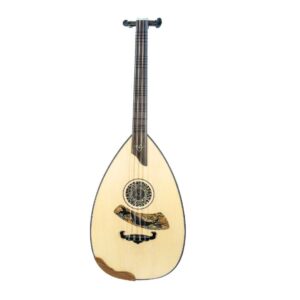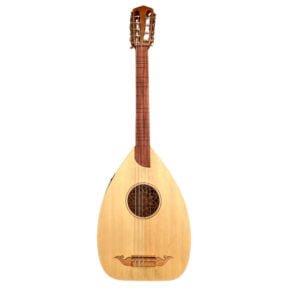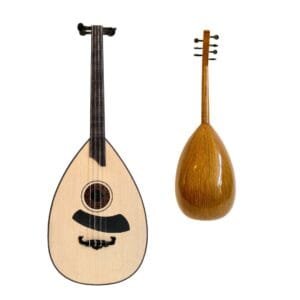Total:
€ 2.377,12
The Turkish Lavta stands as one of the most enchanting stringed instruments in the world of traditional music, captivating musicians with its distinctive pear-shaped body and hauntingly beautiful sound. Whether you're a seasoned collector of ethnic instruments or an aspiring musician drawn to the rich musical heritage of Turkey, choosing the right Lavta requires careful consideration and expert guidance.
This comprehensive buying guide will walk you through everything you need to know about purchasing an authentic Turkish Lavta, from understanding its unique characteristics to making an informed decision that matches your musical aspirations. At Tapadum Ethnic Music Store, we've helped countless musicians discover the perfect traditional instruments, and we're here to share that expertise with you.
The Turkish Lavta is a plucked string instrument that has graced Ottoman courts and folk gatherings for centuries. With its 11 strings arranged in six courses, this instrument produces a rich, resonant sound that bridges the gap between the mandolin and the oud. The Lavta's unique tuning system and playing technique make it an essential instrument for anyone serious about Turkish classical and folk music.
Unlike many other lutes, the Turkish Lavta features a distinctive pear-shaped body carved from quality woods, typically spruce for the soundboard and various hardwoods for the back and sides. The instrument's short neck and fretted fingerboard make it more accessible to beginners while still offering the complexity that advanced players crave.
The foundation of any exceptional Lavta lies in its wood selection and craftsmanship. Premium instruments feature:
Authentic Turkish Lavtas come with 11 strings arranged in 6 courses:
Look for instruments with quality tuning pegs that hold their tension reliably. Traditional wooden pegs require more maintenance but offer authentic appeal, while modern geared tuners provide stability and ease of use.
A well-crafted Lavta should produce:
Consider these playability factors:
Traditional Lavtas maintain historical specifications with:
Modern Lavtas may incorporate:
Different regions of Turkey have developed slight variations in Lavta construction:
Tapadum Ethnic Music Store offers an exceptional collection of authentic Turkish Lavtas, carefully selected from master craftsmen who understand the nuanced requirements of this traditional instrument. Our curated selection ensures that every Lavta meets our strict standards for sound quality, craftsmanship, and authenticity.
When you choose a Turkish Lavta from Tapadum, you're not just purchasing an instrument – you're investing in a piece of cultural heritage crafted by artisans who have dedicated their lives to preserving traditional Turkish music-making. Our expert team is available to help you find the perfect Lavta that matches your skill level, musical goals, and budget.
Visit our traditional string instruments collection to explore our current inventory of Turkish Lavtas, each accompanied by detailed descriptions, high-quality images, and sound samples to help you make an informed decision.
The Turkish Lavta represents more than just a musical instrument – it's a gateway to centuries of musical tradition that has shaped Turkish culture and influenced musicians across the Mediterranean and Middle East. When you own an authentic Lavta, you become part of an unbroken chain of musicians who have used this instrument to express joy, sorrow, celebration, and contemplation.
Learning to play the Lavta connects you with traditional Turkish makams (musical modes) and introduces you to a sophisticated musical system that has influenced classical composers and folk musicians alike. The instrument's versatility allows for both solo performances and ensemble playing, making it an excellent choice for musicians interested in exploring Turkish classical music, folk traditions, or contemporary fusion styles.
Purchasing a Turkish Lavta is an investment in both musical education and cultural appreciation. The journey from selecting your first instrument to mastering its intricate techniques will reward you with a deeper understanding of Turkish musical heritage and the joy of creating beautiful, authentic sounds.
At Tapadum Ethnic Music Store, we understand that choosing the right Lavta is a personal and important decision. Our commitment to quality, authenticity, and customer satisfaction ensures that your Lavta will serve as a faithful musical companion for years to come. The privilege of owning an instrument from our carefully curated collection means joining a community of musicians who value tradition, craftsmanship, and the transformative power of music.
Whether you're taking your first steps into the world of Turkish music or adding to an established collection of ethnic instruments, the right Lavta will open doors to musical experiences that enrich both your artistic journey and your appreciation for global musical traditions.
What draws you most to the Turkish Lavta – its unique sound, its rich cultural heritage, or the challenge of mastering a traditional instrument that bridges Eastern and Western musical traditions?









Mail: info@tapadum.com
Working Days/Hours: Mon – Sun / 10:00 AM – 5:00 PM
Le visite in negozio richiedono un appuntamento